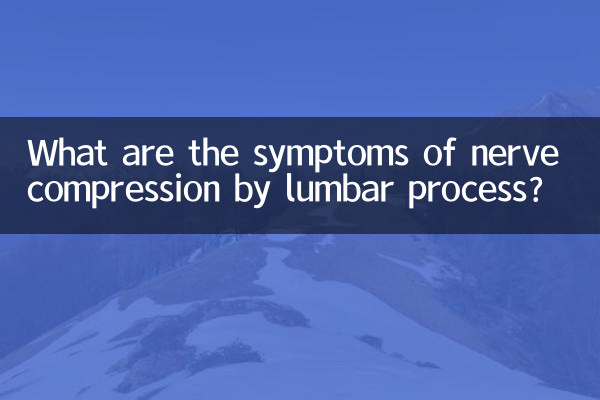What are the symptoms of nerve compression by lumbar process?
Lumbar disc herniation (referred to as "lumbar protrusion") is a common spinal disease. When the herniated disc compresses nerves, it will cause a series of symptoms and seriously affect the patient's quality of life. The following is a detailed analysis of the symptoms, relevant data, and treatment recommendations for nerve compression by the lumbar process.
1. Common symptoms of lumbar process compressing nerves

Symptoms of nerve compression by the lumbar process vary depending on the location and extent of the compressed nerve, but the following are the most common manifestations:
| Symptom type | Specific performance | frequency of occurrence |
|---|---|---|
| Lower limb pain | Pain radiating from the waist to the buttocks, back of the thigh, and outside of the calf (sciatica) | About 80% of patients |
| numbness or tingling | Abnormal sensation in the lower limbs or feet, such as pins and needles or ants walking | About 60-70% of patients |
| muscle weakness | Weakness in the feet or toes, which may affect walking in severe cases | About 30-40% of patients |
| Reduced reflection | Decreased or absent knee jerk or ankle reflexes | About 20-30% of patients |
| bladder dysfunction | In severe cases, difficulty urinating or incontinence may occur (urgent medical attention is required) | <5% patients |
2. Symptoms and characteristics of lumbar protrusion at different segments
Lumbar disc herniation often occurs at the L4-L5 and L5-S1 segments. The symptoms corresponding to the compressed nerves at different segments are as follows:
| protruding segment | pinched nerve | Typical symptoms |
|---|---|---|
| L3-L4 | L4 nerve root | Pain in the front of the thigh and weakened knee reflexes |
| L4-L5 | L5 nerve root | Pain on the outside of the calf, numbness on the dorsum of the foot, and weakness in the big toe |
| L5-S1 | S1 nerve root | Heel pain, numbness on the sole of the foot, weakened ankle reflexes |
3. Recent hot topics: innovative progress in lumbar protrusion treatment
According to the analysis of the entire network search data in the past 10 days, the following topics have become the focus of attention:
| hot topics | Discuss the popularity index | core content |
|---|---|---|
| Stem cell treatment for lumbar protrusion | ★★★★☆ | The application prospects of regenerative medicine in intervertebral disc repair |
| minimally invasive surgery comparison | ★★★★★ | Analysis of the pros and cons of transforaminal endoscopy and UBE technology |
| Home rehabilitation training | ★★★☆☆ | Short video instruction on McKenzie Therapy and core muscle group exercises |
4. Diagnosis and treatment suggestions
1.Diagnosis method:MRI is the gold standard for diagnosing lumbar protrusion, and CT and electromyography can be used as auxiliary examinations.
2.Conservative treatment:About 80% of patients can be relieved by:
- Bed rest in acute phase (no more than 3 days)
- NSAIDs (such as ibuprofen)
- Physiotherapy (traction, ultrashort wave)
- Epidural injection
3.Indications for surgery:Surgery may need to be considered in the following situations:
- Pain that persists for >6 weeks and conservative treatment is ineffective
- Progressive loss of muscle strength
- Cauda equina syndrome (urinary and fecal dysfunction)
5. Preventive measures
1. Maintain correct sitting posture and avoid sitting for more than 1 hour.
2. Strengthen waist and back muscle exercises (such as Xiaoyanfei, swimming)
3. Control your weight, the recommended BMI is <25
4. Use your legs instead of your waist when carrying heavy objects
If suspected symptoms occur, it is recommended to seek medical examination as soon as possible to avoid delaying treatment. The recovery rate of early intervention can reach more than 90%, but the chronic course of the disease may leave long-term functional impairment.

check the details

check the details